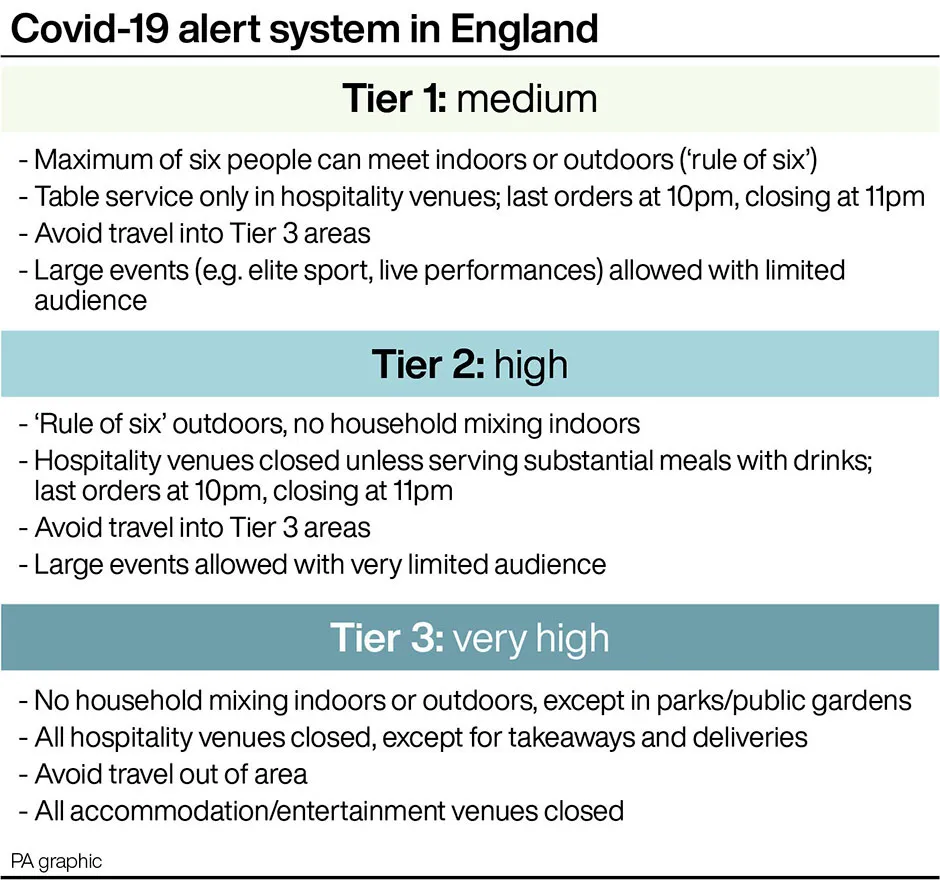Tier 1 measures alone are not enough to prevent the rapid growth of coronavirus, and a fourth tier may be needed in areas where Tier 3 restrictions are not sufficient, government scientific advisers have warned.
The Sage scientific advisory panel said the tiers implemented across England before the second national lockdown had an impact on viral transmission with higher tiers having more effect.However, documents released by Sage on Monday said Tier 1 measures alone “are not enough to prevent the epidemic from growing rapidly”.
In a meeting on 12 November, the group concluded that some models suggested a modest (approximately 10 per cent) reduction in the reproduction number – the R value – when moving from Tier 1 to 2.
In some places Tier 2 could be enough to reduce R below 1, but this has not yet been observed, and would be the case if R was only slightly above 1 before Tier 2 was implemented, the scientists said.
Read the latest coronavirus news:
- AstraZeneca/Oxford: How long until we can be vaccinated?
- COVID-19: Oxford vaccine produces 'robust' response in older adults
- Pfizer-BioNTech COVID-19 vaccine more than 94 per cent effective in the over 65s
The document added: “This suggests that Tier 2 is the minimum intervention required to maintain any degree of control on transmission, though this would not be the case in all places and there is significant uncertainty. In most cases moving from Tier 1 to Tier 2 would slow growth rather than reverse it.”
A separate Scientific Pandemic Influenza Group on Modelling, Operational sub-group (SPI-M-O) statement dated 11 November suggested a “Tier 4” may be required in areas where Tier 3 restrictions are not reducing numbers.
It read: “There is a great deal of uncertainty about the effect of tiers, particularly Tier 3. Test and trace, including mass testing, is most effective when prevalence is low. Even the most effective test and trace system will have little impact when caseloads are high.

“Given that the impact of tiers will vary depending on the characteristics of different areas, a ‘Tier 4’ needs to be considered for those parts of the country where Tier 3 is not able to shrink the epidemic.
“This is particularly important in the run-up to the winter festive period if relaxation of measures is under consideration. Keeping incidence flat or decreasing between now and then is crucial.”
Sage set out that it is unclear whether baseline Tier 3 restriction alone would be sufficient at a regional or national level to reduce R below 1.

The 12 November documents said: “It is almost certain that prevalence will remain high in some parts of the country at the end of the current national restrictions.
“When policymakers plan transitions from national measures to a localised approach, or between tiers in future, consideration will need to be given to both prevalence and growth rate of new infections.”
The other nations in the UK are under different rules. Northern Ireland begins a two-week circuit breaker lockdown from Friday 27 November, while Scotland has a five-tier system in place. Wales has no tier system following the lifting of its lockdown on 9 November.
How can I protect myself from the coronavirus when shopping?
You’ll have seen signs in your local supermarket advising you to keep two metres from others while moving around the store. This is key to reducing your chances of catching the virus while shopping.
The coronavirus SARS-CoV-2 is spread through respiratory droplets that leave our mouth and nose when we cough, sneeze, or sometimes even talk. The droplets sprayed out by an infected person will contain the virus, which could then enter your body via your mouth, nose or eyes (this is why you shouldn’t be touching your face).
Respiratory droplets don’t usually travel more than one metre, so by keeping two metres from others, you’ll reduce the likelihood of being in the firing line. To make it easier to keep your distance, try to shop during off-peak hours, choose a store that’s limiting the number of people who can be inside at any one time, and use self-checkout if you can.
Keeping your hands clean is the other main thing you can do. If possible, wipe the trolley or basket handles with a disinfectant wipe when you arrive at the store. When you get home, wash your hands or use hand sanitiser before and after unpacking your bags.
A US study found that the coronavirus can survive for up to 24 hours on cardboard, and up to three days on hard, shiny surfaces such as plastic, so wiping down your purchases with a disinfectant spray or a soapy cloth before you put them away is another good habit to get into.
Read more: